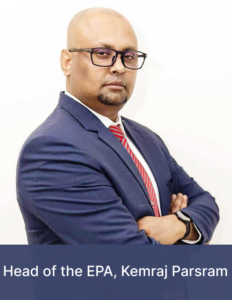

Executive Director of the EPA, Dr. Kemraj Parsram says he is acutely aware of the need to maintain this delicate balance, hence strategic investments are being made to ensure the EPA becomes a world-class regulator.
During his inaugural appearance on the Energy Perspectives podcast, a programme powered by the Guyana Energy Conference & Supply Chain Expo, the Executive Director explained how technology is being leveraged to ensure remote monitoring of the oil and gas sector.
With respect to monitoring water quality, he noted that there are sensors on Guyana’s three FPSOs—Liza Destiny, Liza Unity, and Prosperity. As part of the operator’s responsibility, he said ExxonMobil and its partners must measure, for example, the concentration of oil in produced water that is being discharged.
Parsram said too that ExxonMobil is required to treat the water in alignment with World Bank standards before it is discharged. Parsram said these standards outline that there can only be 49 milligrams per day or an average 29 milligrams of oil per litre per month.
“So, they have these sensors that measure and provide us with that feed. We have a live platform at the EPA where we can see, by the minute, the concentration of oil in produced water,” said the Executive Director.
He noted that these sensors also allow the regulator to monitor how much gas is flared too.
“As you know, Guyana prohibits routine flaring…if there is an upset condition and you are testing out a new equipment, you are allowed to flare within a certain limit and if you go beyond, then a flaring fee of US$50 per tonne of every carbon emitted is charged,” he said.
Furthermore, Parsram said the EPA utilizes NASA’s satellites to monitor any incident of flaring as well as MAXAR technology to have a bird’s eye view of any spill.
Parsram also noted his interest in leveraging big data analytics and AI as the agency progresses while also ensuring that the staff remains in a continuous training cycle.
“We have invested in the past year, $40 to $50 million for specific training on oil spill response, rig and FPSO inspection and we are investing to ensure we have the adequate cadre of skills to execute our functions.”
Parsram also shared that his agency has completed a strategic plan covering the next five years, all with the sole intention of laying out a roadmap to become a world class environmental regulator. He believes that is not only achievable but will also position Guyana as an example for other nations to follow.
